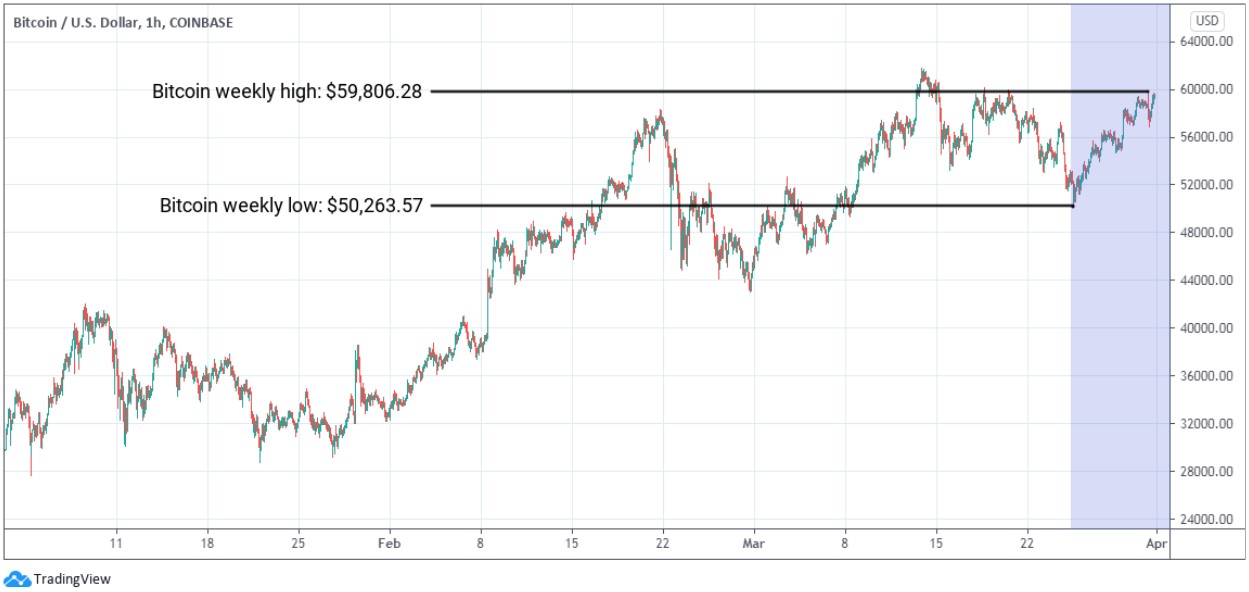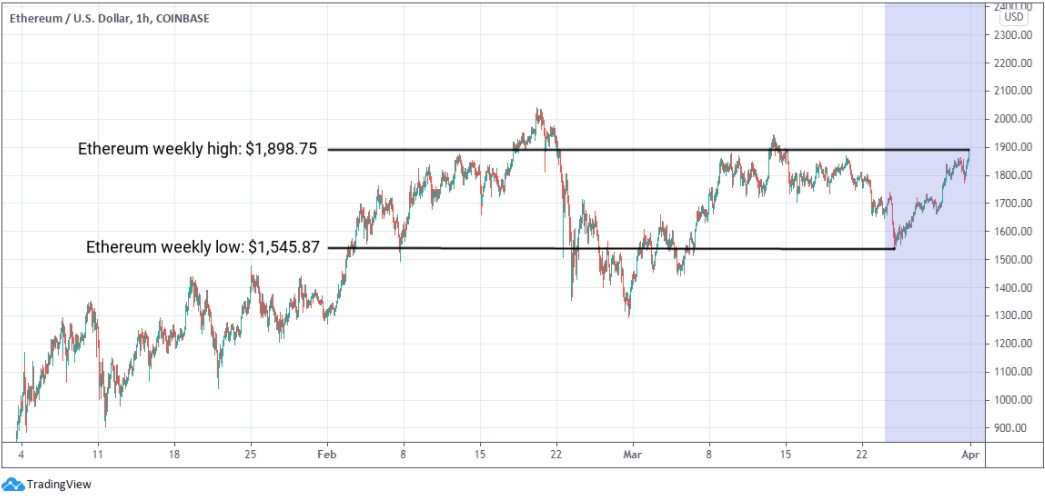ETC Group Crypto Minutes Week #13
BNY Mellon, Mastercard and the world's biggest asset manager Blackrock make moves into crypto infrastructure
BNY Mellon, Mastercard and the world's biggest asset manager Blackrock make moves into crypto infrastructure

It’s no particular secret that wealthy investors are seeking ever greater exposure to Bitcoin and cryptocurrencies in general. The largest custodian bank by assets, BNY Mellon BNY Mellon, payments behemoth Mastercard Mastercard and the world’s biggest asset manager Blackrock Blackrock have all made moves into crypto infrastructure in 2021.
Adding fuel to the fire of the exploding interest in this nascent asset class this week was the chief investment officer of Soros Fund Management, Dawn Fitzpatrick.
She told Bloomberg’s Front Row on 26 March 2021 that she sees cryptocurrency at “an inflection point”, noting that the $27bn AUM hedge fund had been making investments in infrastructure companies, including crypto custodians; asset managers; cryptoexchanges and tax reporting service providers. Soros Fund Management is generally regarded as one of the most successful hedge funds of all time, returning 44% annually since it was founded in 1970.
Fitzpatrick’s words echo the suggestion made in a Citibank research note from the beginning of the month, where analysts said Bitcoin was at “a tipping point” for mainstream acceptance that could see it become the preferred currency of choice for international trade.
But it was confirmation this week from Visa, that it has become the first major payments network to settle payments in the stablecoin USDC, that has really seen cryptocurrencies hit the mainstream.
The announcement today marks a major milestone in our ability to address the needs of fintechs managing their business in a stablecoin or cryptocurrency. Jack Forestell, Chief product officer
According to a Reuters exclusive, later confirmed by the $456bn market cap multinational, Visa will settle USDC transactions using the Ethereum blockchain. This removes the need to convert cryptocurrencies into fiat in order to settle payments. The settlement agent for Visa’s USDC transactions is Anchorage, which in January 2021 became the first federally-chartered cryptocurrency bank , as approved by the US Office of the Comptroller of the Currency (OCC).
These moves are among the first real-world results of regulatory guidance laid out in summer 2020 and early 2021 by the former head of the OCC (and former Coinbase legal chief) Brian Brooks. It was his Interpretive Letters that allowed US banks the legal leeway to act as nodes on blockchain networks and use stablecoins for payment settlement, as well as custody cryptoassets for their clients.
In other news, the UK’s tax office HMRC has updated its 2019 guidance on the treatment of cryptoassets to include income from staking in Proof of Stake networks. The revision collates two existing sets of guidelines for individuals and businesses into one single document and marks the first time that the authority has made a clear point of difference between the rewards gained from cryptocurrency mining and staking. Previously it was assumed that the two types of reward-seeking from cryptocurrencies would be treated the same under UK tax law.
HMRC’s older 2019 guidance came before the rapid expansion in the largely Ethereum-based DeFi and NFT markets, and before the wide-scale institutional adoption of cryptocurrencies as treasury reserve assets.
The rise of highly-liquid DeFi marketplaces, and the subsequent ability of companies and individuals to stake their owned cryptocurrency has, for many, transformed the investment case. In effect it turns a non-yielding asset into one that produces additional rewards, like any dividend-paying equity, with the obvious risks also attached.
And as one of the world’s financial centres the UK has long sought to be the first to provide clear regulatory guidance on cryptoassets.
The new documents say that the taxation of staking activities by businesses depends on whether the activity falls under the definition of “a taxable trade”. This depends on a range of factors, including the commerciality of the activity, the nature of the organisation involved, and the degree of risk involved. If it is determined to be “trade”, profits must be calculated “according the relevant tax rules” but “with any appropriate expenses reducing the amount chargeable”. HMRC noted that any cryptoasset sold for profit would be subject to capital gains tax and corporation tax on chargeable gains.
If staking activity does not amount to trade, HMRC said the pound sterling value of cryptoassets awarded would be taxable as miscellaneous income.
In a statement to industry news website Coindesk, a HMRC spokesperson said the guidance formed part of a “more flexible approach to updating customers in this fast-moving sector.”
Another Reuters exclusive on 30 March 2021 explained how Paypal had launched a crypto ‘checkout’ service to allow its US customers to use their bitcoin, ether, litecoin or bitcoin cash holdings to pay at 29 million online merchants globally.
This is the first time you can seamlessly use cryptocurrencies in the same way as a credit card or debit card inside your Paypal wallet, Dan Schulman, CEO
Customers who hold one of the four supported cryptoassets can convert them into fiat at checkouts to make purchases.
Reuters chief fintech correspondent Anna Irrera noted that it was “a move that could significantly boost use of digital assets in everyday commerce”.
In the markets this week, Bitcoin fell to a three-week low of $50,623 late on Wednesday 24 March where it touched $50,263. As the week continued the BTC price retested the much-vaunted $60,000 level. This is an area of significant psychological resistance, much like the $50,000 price point has become recent support.
Overall positive market sentiment for Bitcoin, like any other financial asset — gold at $2,000 per ounce, for example — is somewhat dictated by these arbitrary round numbers.

In the week to 31 March 2021 Ethereum dipped by 6.6% to a three-week low of $1,545.87 before paring back those losses. The ETH price briefly spiked towards the $1,900 mark before settling at $1,898.75.

Important information:
This article does not constitute investment advice, nor does it constitute an offer or solicitation to buy financial products. This article is for general informational purposes only, and there is no explicit or implicit assurance or guarantee regarding the fairness, accuracy, completeness, or correctness of this article or the opinions contained therein. It is advised not to rely on the fairness, accuracy, completeness, or correctness of this article or the opinions contained therein. Please note that this article is neither investment advice nor an offer or solicitation to acquire financial products or cryptocurrencies.
Before investing in crypto ETPs, potentional investors should consider the following:
Potential investors should seek independent advice and consider relevant information contained in the base prospectus and the final terms for the ETPs, especially the risk factors mentioned therein. The invested capital is at risk, and losses up to the amount invested are possible. The product is subject to inherent counterparty risk with respect to the issuer of the ETPs and may incur losses up to a total loss if the issuer fails to fulfill its contractual obligations. The legal structure of ETPs is equivalent to that of a debt security. ETPs are treated like other securities.
Bitwise is one of the world’s leading crypto specialist asset managers. Thousands of financial advisors, family offices, and institutional investors across the globe have partnered with us to understand and access the opportunities in crypto. Since 2017, Bitwise has established a track record of excellence managing a broad suite of index and active solutions across ETPs, separately managed accounts, private funds, and hedge fund strategies—spanning both the U.S. and Europe.
In Europe, for the past four years Bitwise (previously ETC Group) has developed an extensive and innovative suite of crypto ETPs, including Europe’s largest and most liquid bitcoin ETP.
This family of crypto ETPs is domiciled in Germany and approved by BaFin. We exclusively partner with reputable entities from the traditional financial industry, ensuring that 100% of the assets are securely stored offline (cold storage) through regulated custodians.
Our European products comprise a collection of carefully designed financial instruments that seamlessly integrate into any professional portfolio, providing comprehensive exposure to crypto as an asset class. Access is straightforward via major European stock exchanges, with primary listings on Xetra, the most liquid exchange for ETF trading in Europe.
Retail investors benefit from easy access through numerous DIY/online brokers, coupled with our robust and secure physical ETP structure, which includes a redemption feature.